Guatemala is a small country adjacent to Mexico, Belize, Honduras and El Salvador and is bordered by the Caribbean Sea and the Pacific Ocean. With its hot, tropical climate, Guatemala contains jungles full of lush vegetation and abundant wildlife such as toucans, macaws, jaguars and 60 species of bats. The Guatemalan jungles are also home to many threatened and endangered species such as ocellated turkeys, crested eagles and several cat species such as ocelots, margays, jaguarundis, and pumas. In addition to the natural beauty of this country, the ancient Mayans and Spanish colonists both left their marks across the landscape. So expect to see Guatemala landmarks of cultural, natural and historical significance while exploring this small Latin American country.
Contents
- Guatemala Landmarks
- 3 Top Guatemala Tours
- Natural Landmarks in Guatemala
- Historical Landmarks In Guatemala
- 7- Tikal National Park
- 8- Iximche
- 9- Convento de las Capuchinas
- 10- Ruins of Uaxactun
- 11- Convento Santa Clara
- 12- Livingston
- 13- Cathedral of Guatemala City
- 14- Castillo de San Felipe de Lara
- 15- Yaxhá
- 16- Arco de Santa Catalina
- 17- Antigua Guatemala
- 18- Chichicastenango Market
- 19- San Antonio Palopo
- 20- Quirigua
Guatemala Landmarks
3 Top Guatemala Tours
- Pacaya Volcano Trek – hike this iconic landmark and see the impressive lava flows.
- Tikal Day Tour – Explore the Mayan ruins of Tikal.
- Lake Atitlan Cruise – Cruise the lake and explore local villages.
Natural Landmarks in Guatemala
1- Cerro de la Cruz
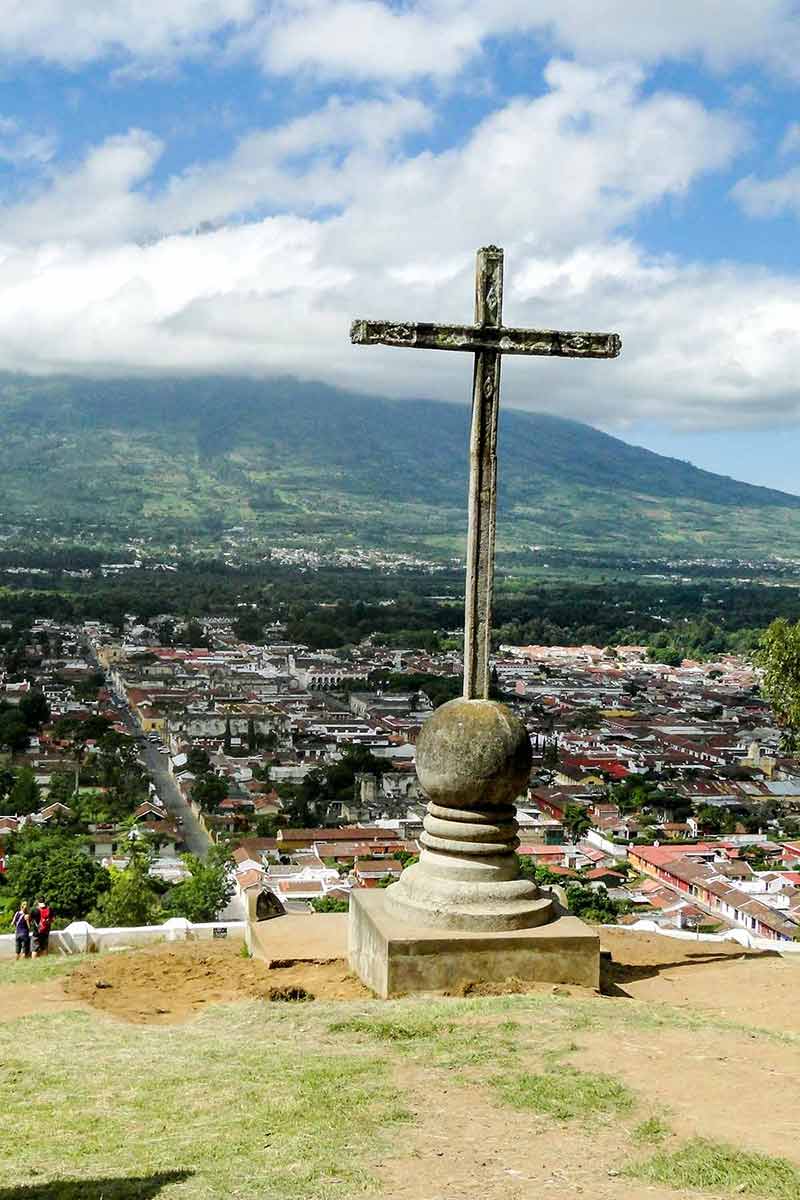
Cerro de la Cruz, or Hill of the Cross, is a small mountain that lies adjacent to the city of Antigua in Guatemala.
This mountain has panoramic city views and is a popular spot to visit.
Visitors to this mountaintop can see the colours of the city below as well as many important historical Guatemalan landmarks in the city.
The top of this mountain has a cement cross mounted on it, and locals climb the hill as a part of one of the Catholic holidays in the spring.
2- Lake Atitlán (Lago de Atitlán)
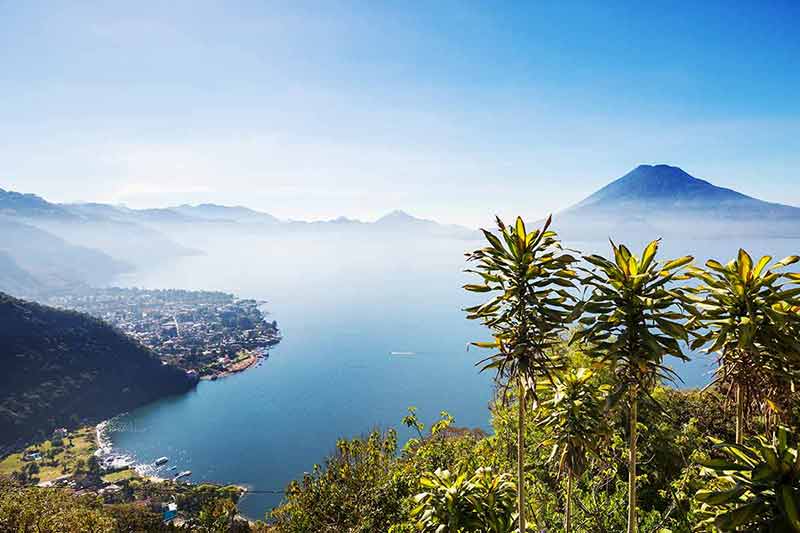
Lake Atitlan is in the highlands of Guatemala and is surrounded on three sides by three different volcanoes.
It’s one of the deepest lakes in Central America.
It requires less than two hours to drive to this lake from Guatemala City and visitors usually choose to stay in the small town of Panajachel.
Several small villages surround this lake, each specialising in a specific craft and continuing to live the traditional Mayan lifestyle.
This area has attracted expatriates who move to one of the small villages on the lake and live a relaxed hippy lifestyle.
Cruise the lake and visit the villages of San Juan La Laguna and Santiago Atitlan on this full-day tour.
3- Pacaya Volcano, Antigua
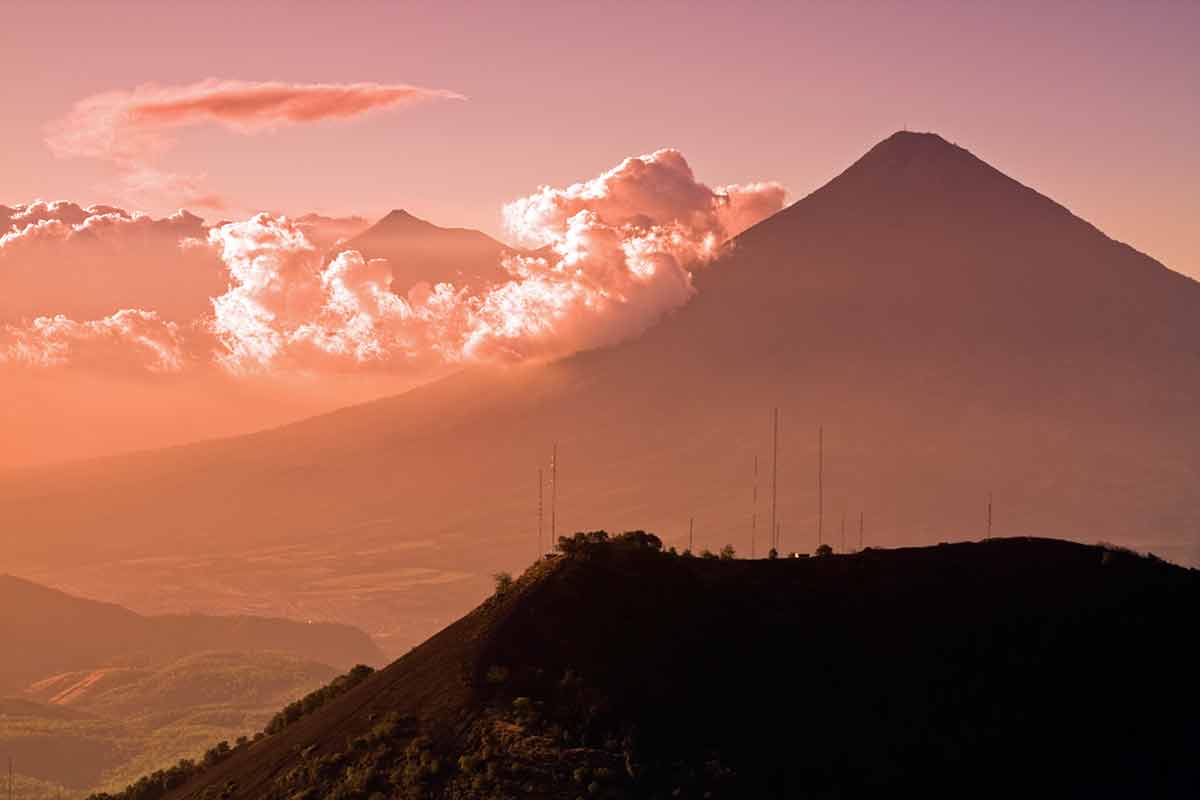
The Pacaya Volcano has been continuously active for the last 60 years.
It is near Guatemala City and Antigua; hiking tours to this volcano are available from Antigua.
If you’re keen on hiking the volcano, make sure you go with an experienced guide because of the volcano’s level of activity.
This is an excellent day trip for the adventurous tourist who wants to see an active volcano up close and roast marshmallows over hot spots. Join this hiking tour of the volcano.
For adventurers who do not wish to hike, horseback riding tours on the volcano are also available.
4- Grutas de Lanquín (Lanquín Caves)
Grutas de Lanquin or Lanquin Caves are a large complex of deep limestone caverns near Coban, designated as a national park.
The ancient Mayans believed that caves were sacred places and an entrance to the underworld, so many rituals occurred here.
These caverns are so extensive that sections of the complex are still unexplored, so no one knows exactly how far they run underground.
Accessing the caves requires hiking through water and even jumping over a small waterfall.
This natural landmark of Guatemala is also an important habitat for bats.
Every evening, bats rush out of the caves to feed and provide a unique viewing experience for visitors.
5- Biotopo Monterrico-Hawaii (Nature Reserve)
Biotopo Monterrico-Hawaii is a nature reserve on the Pacific coast of Guatemala, just north of the El Salvador border, near the town of Monterrico.
This coastal reserve contains mangrove swamps that are connected by canals and is a biodiverse area containing a wide range of bird and aquatic species.
Some species found here are endangered, including Leatherback turtles and Ridley turtles.
Boat tours through the mangrove canals for birdwatching are available and nighttime tours to watch turtles lay their eggs are a fantastic experience.
The best time for birdwatching at this reserve is January to February.
6- Semuc Champey
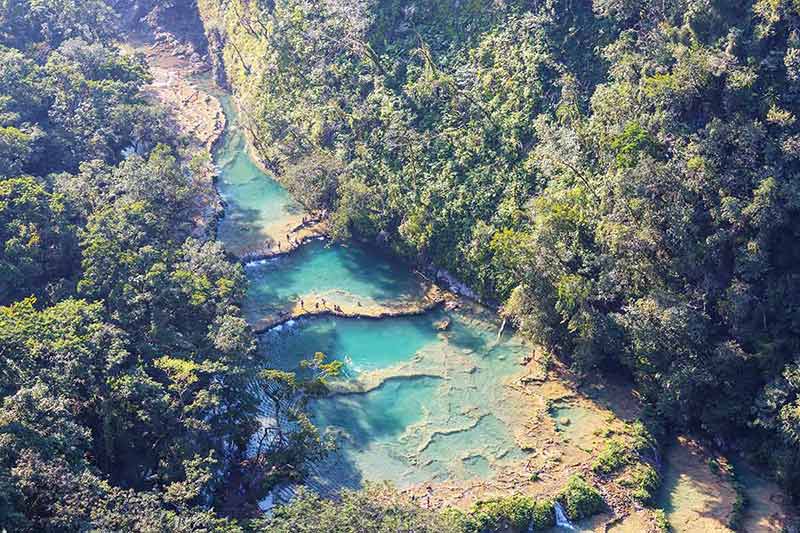
Semuc Champey is a natural monument near the small town of Lanquin, which is difficult to access because of its location deep within the jungle.
Semuc Champey has a 984 ft (300m) long natural bridge covering a portion of the Cahabon River.
A highlight is the stepped, turquoise-coloured pools that are popular places to swim.
In addition to swimming in these pools, visitors can tube down the river or explore the nearby water cave, K’an Ba Cave, with a candle.
To view Semuc Champey from above, there’s an uphill track through the jungle to an overlook.
Join a 3-day adventure tour of Semuc Champey and hike through the El Biotopo del Quetzal in Coban.
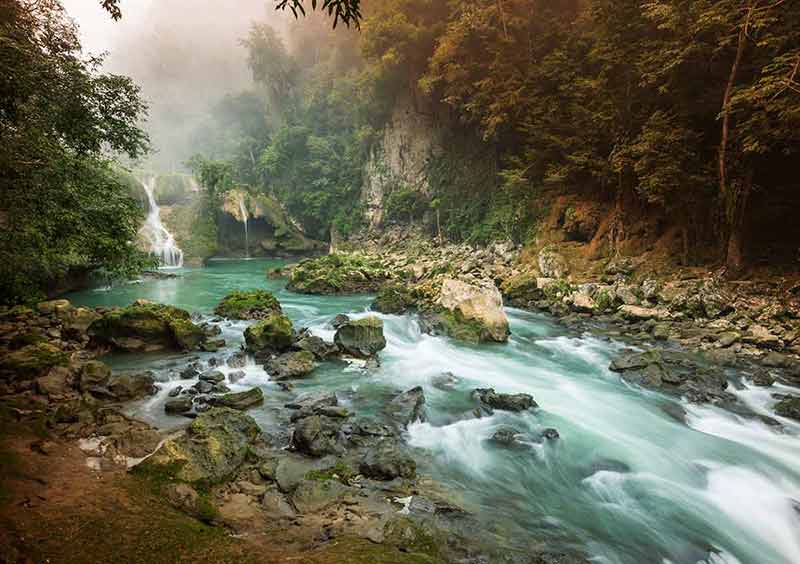
Historical Landmarks In Guatemala
7- Tikal National Park
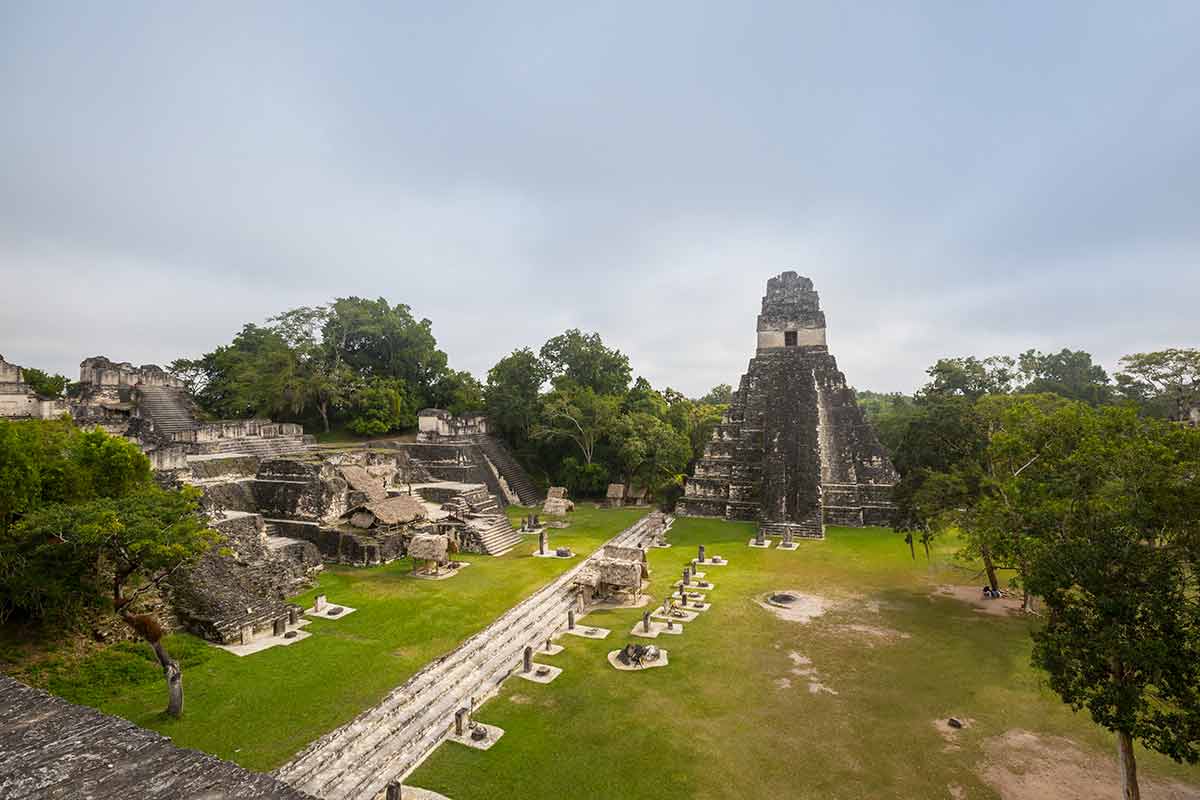
Tikal National Park, located near the border with Belize, is a jungle that contains a UNESCO World Heritage-listed ancient Mayan city.
The archaeological site within the national park is the largest in North America, with more than 3,000 excavated structures.
The ruins of Tikal lie in the middle of the jungle, a part of the Maya Biosphere Reserve.
Scientists believe this city was created in 800 B.C. and last occupied around 900 A.D.
The Maya Biosphere Reserve encompasses the Tikal National Park to maintain the historical, cultural and natural integrity of the Tikal ruins and the jungle surrounding them. Here’s a tour of Tikal you may like.
8- Iximche
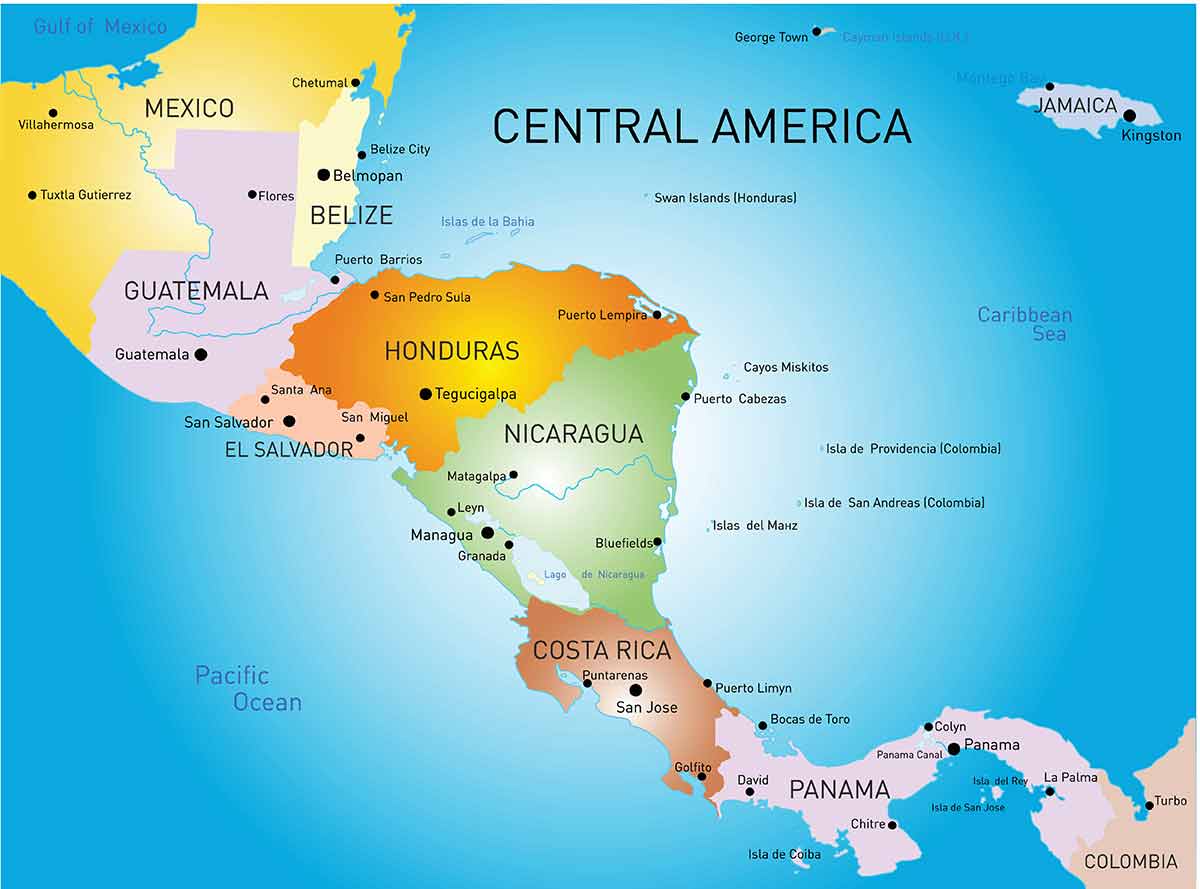
Iximche was the capital of the Mayan people in the 15th and 16th centuries.
The ruins at this archaeological site contain several pyramids, palaces, ball courts, and other structures.
Iximche is in the western highlands, near Tecpan, and not far from Lake Atitlan.
This site sees fewer international visitors than Tikal but is a popular place for Guatemalan travellers who visit this site as pilgrims to celebrate some cultural aspects of their history.
Many of these artifacts are displayed at a small museum in a nearby town.
9- Convento de las Capuchinas
Iglesia y Convento de las Capuchinas or Church and Convent of the Capuchins is a beautiful 18th-century construction located in Antigua in Guatemala.
The nuns abandoned this convent after only 40 years when the 1773 earthquake made it unsafe, but it has been partially renovated and is open to the public.
The nuns that came to this convent to live had no contact with the outside world once they were within the walls.
They lived here in what historians consider the first apartment building in the Americas.
There’s a museum on the first floor, and the caretakers like to tell visitors that this building has some paranormal activity.
10- Ruins of Uaxactun
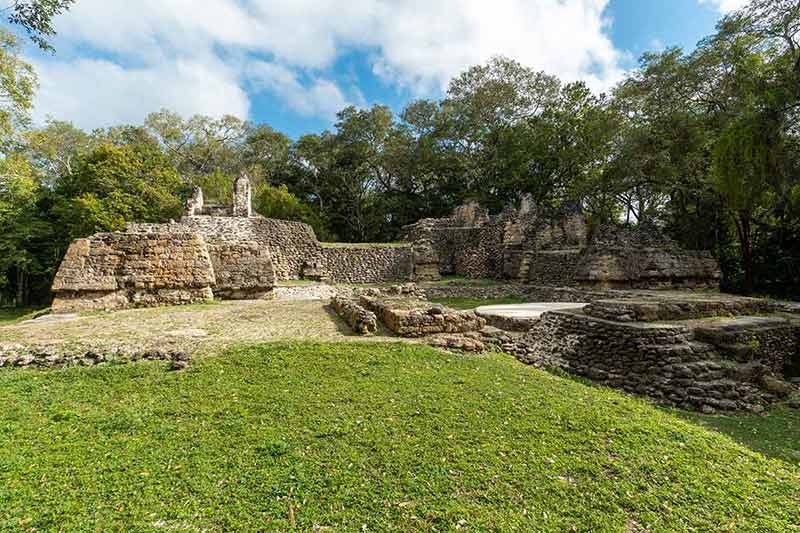
The archaeological ruins of Uaxactun are near Peten and this ancient Mayan city is not far from the ruins at Tikal.
Like Tikal, Uaxactun is within the Tikal National Park and the vast Maya Biosphere Reserve jungle.
Mayans occupied this site from around 900 B.C. until sometime in the 10th century.
The many ruins found at this site include pyramids, temples, ball courts, and other structures.
Archaeologists believe that Uaxactun was an important astronomical complex for the Mayans.
Many artifacts have been found during the extensive excavations and restorations conducted at Uaxactun. Some are on display in a small museum in a nearby town.
Also read:
- 20 USA Landmarks
- 23 Canada Landmarks
- 22 Ohio Landmarks
- 21 Arizona Landmarks
- 21 Minnesota Landmarks
- 21 Oregon Landmarks
- 21 Illinois Landmarks
- 21 Colorado Landmarks
- 21 Georgia Landmarks
- 21 Michigan Landmarks
- 23 Los Angeles Landmarks
- 21 Washington Landmarks
- 21 Maryland Landmarks
- 20 Manitoba Landmarks
- 20 Kansas Landmarks
- 21 New Mexico Landmarks
- 20 Idaho Landmarks
- 20 Montana Landmarks
- 20 Oklahoma Landmarks
- 21 Wisconsin Landmarks
- 20 Tennessee Landmarks
- 21 Iowa Landmarks
- 20 Alaska Landmarks
- 20 Miami Landmarks
- 21 West Virginia Landmarks
- 21 Kentucky Landmarks
- 20 Louisiana Landmarks
- 21 Arkansas Landmarks
- 20 Cincinnati Landmarks
- 20 San Antonio Landmarks
- 25 Indiana Landmarks
- 21 New York Landmarks
- 20 Texas Landmarks
- 21 Boston Landmarks
- 20 Florida Landmarks
- 20 Hawaii Landmarks
- 5 South Dakota Landmarks
- 21 Pennsylvania Landmarks
- 23 New Jersey Landmarks
- 21 Virginia Landmarks
- 21 North Carolina Landmarks
- 21 Utah Landmarks
- 21 Nevada Landmarks
- 20 Massachusetts Landmarks
- 20 Washington DC Landmarks
- 20 Vermont Landmarks
- 20 Nebraska Landmarks
- 20 North Dakota Landmarks
- 21 Missouri Landmarks
- 20 Rhode Island Landmarks
- 21 Maine Landmarks
- 21 Connecticut Landmarks
- 20 San Diego Landmarks
- 20 Landmarks In South Carolina
- 20 Mississippi Landmarks
- 20 Las Vegas Landmarks
- 20 Dallas Landmarks
- 20 Houston Landmarks
- 20 Seattle Landmarks
11- Convento Santa Clara
The Santa Clara Convent and Temple in Antigua was constructed in 1715.
Like the Convent of the Capuchins, the nuns in the Santa Clara Convent were not allowed to leave the building or contact the outside world once they entered the convent.
However, multiple earthquakes interrupted their solitude, and the nuns were forced to live elsewhere until the building reconstruction was completed in 1734.
The earthquake in 1773 severely damaged the building, and at that point, the convent was abandoned.
Over the next several decades, additional earthquakes left the convent in ruins.
Today, visitors to the convent can wander through the ruins and the gardens.
The temple’s facade is marked by stucco ornamentation and figures of archangels and is still one of the most impressive building facades in the city.
12- Livingston
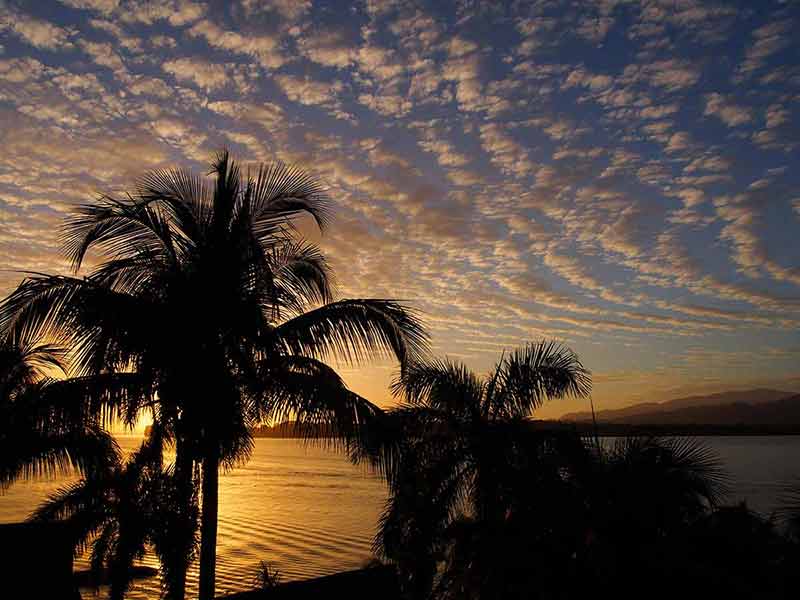
Livingston is a brightly-painted beach town on the Caribbean coast of Guatemala.
Much of this town is populated by the Garifuna, descendants of African people who washed ashore from a slave ship.
The culture of the Garifuna has influenced the food and culture of this village.
Try a popular local dish called tapado, a seafood stew in coconut broth, or some gifiti, an alcoholic rum brew.
A short walk from Livingston, Los Siete Altares has lovely waterfalls where you can swim.
Another popular activity is birdwatching at Punta de Manabique, just across the water from the town.
To reach Livingston, travellers must take a boat because there is no land connection to the village on the peninsula.
13- Cathedral of Guatemala City
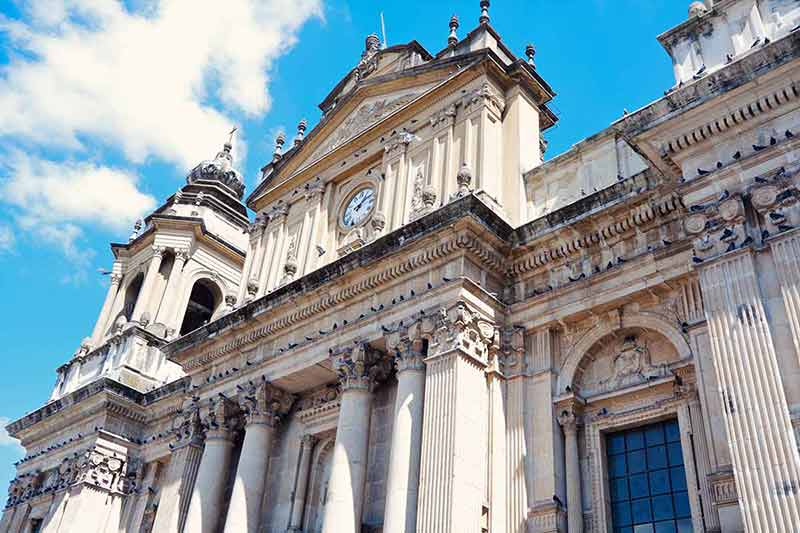
The Cathedral of Guatemala City, formally known as the Holy Church Cathedral Metropolitan Basilica of Santiago de Guatemala or the Metropolitan Cathedral, is the city’s main cathedral.
It is located in the city’s central square and is a sizeable baroque construction that has survived the many earthquakes that often rock this region.
12 pillars stand in front of the cathedral to commemorate the thousands of people who were murdered (or disappeared) during a violent time from 1960 to 1996.
14- Castillo de San Felipe de Lara
Castillo de San Felipe de Lara is a castle built on the banks of the Rio Dulce at the entrance to Lake Izabal.
The Spanish constructed this National Historical Monument to protect themselves from the English pirates who roamed the Caribbean waters.
Originally built in the mid-1600s, pirates burned it down in 1686.
More pirates continued to burn down and loot this castle over the next couple hundred years.
The castle is open to the public and is a popular attraction in the Rio Dulce National Park area.
15- Yaxhá
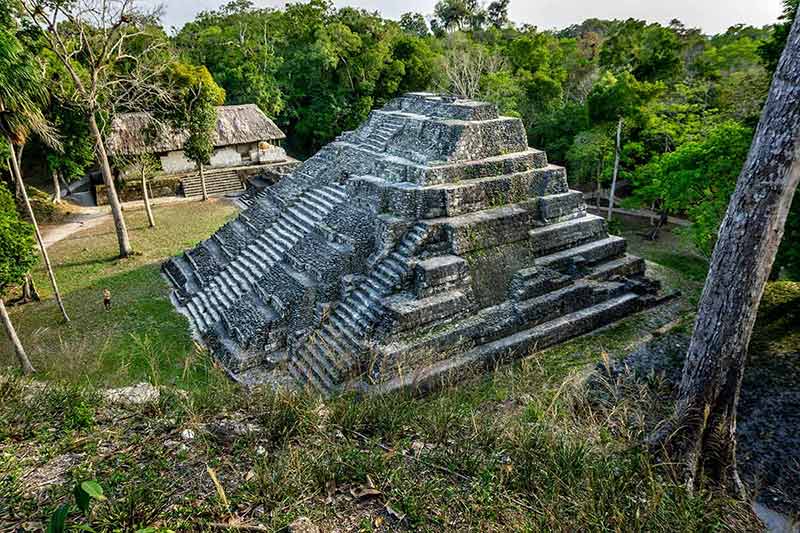
Yaxha is an ancient Mayan archaeological site near the ruins of Tikal in northern Guatemala.
The city of Yaxha was once the third-largest Mayan city and was occupied from around 1000 B.C. until the 16th century.
The ancient ruins include a large Acropolis, a twin pyramid complex and hundreds of other buildings that include pyramids, temples, ball courts and other structures.
Yaxha National Park also contains other Mayan ruins smaller than those at Yaxha.
Because of the extensive biodiversity existing within this national park, Yaxha is a RAMSAR Wetland of Global Importance. Join this tour to visit Yaxha.
Discover more Famous World Landmarks:
- 25 Australian Landmarks
- 20 New Zealand Landmarks
- 20 African Landmarks
- 21 Egyptian Landmarks
- 20 Jordan Landmarks
- 10 Tasmanian Landmarks
- 20 Antarctica Landmarks
16- Arco de Santa Catalina
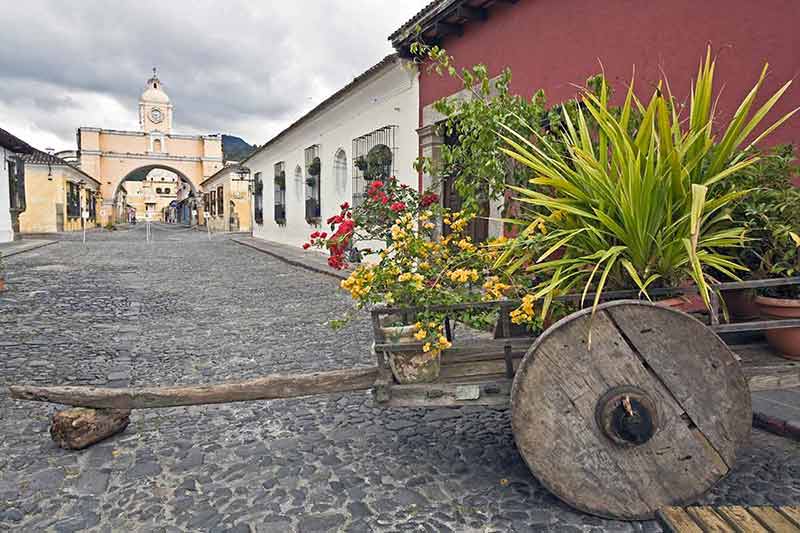
Arco de Santa Catalina, or Santa Catalina Arch, is an iconic arch and well-known landmark on 5th Avenue North in Antigua.
This arch was constructed in the late 1600s at the request of the Santa Catalina convent nuns to connect the main convent building to an expansion across the street.
As the nuns were cloistered from the outside world and were not allowed outside their convent, the arch allowed them to access the other side of the street.
Despite the numerous earthquakes in the region, the arch has continued to stand but requires repairs and restoration.
After the 1773 earthquake, the arch’s restorers added the turret and clock that are now a part of this iconic Guatemala landmark. Here’s a tour of Antigua from Guatemala City.
17- Antigua Guatemala
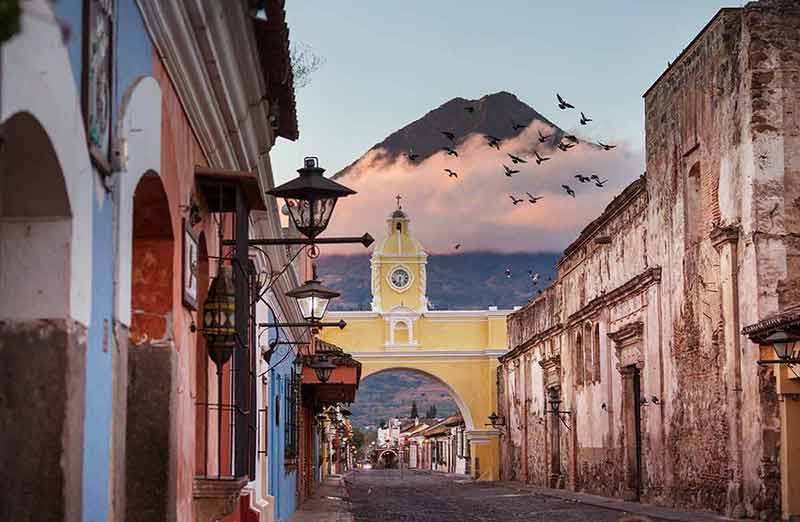
Antigua Guatemala, commonly called Antigua, is near Guatemala City in a valley between three volcanoes.
The city was once the capital of the Kingdom of Guatemala and is listed as a UNESCO World Heritage Site.
During the Spanish occupation of Guatemala, Antigua was the country’s capital city until the 1773 Santa Marta earthquake that demolished much of the city.
As a result of the devastation, the Spanish crown moved the capital to its current location in Guatemala City.
Antigua is a colourful city with many ruins open to the public that are remnants of the damage from earthquakes in this area. Explore Antigua on a day tour from Guatemala City.
18- Chichicastenango Market
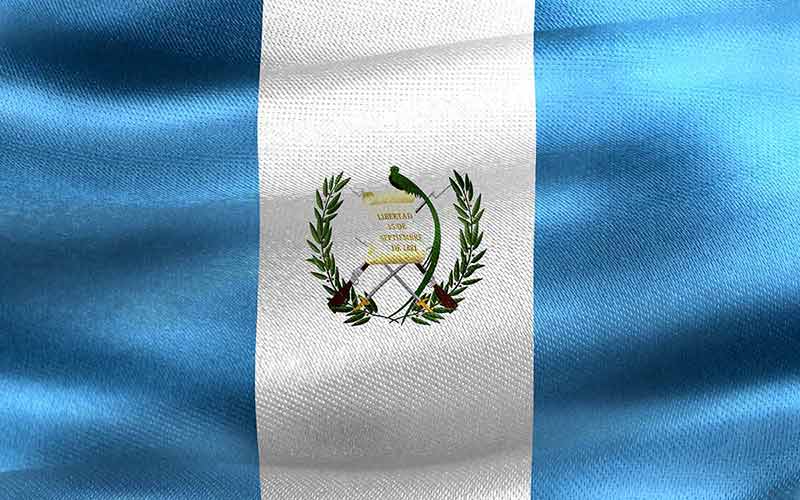
Chichicastenango Market (or Chichi) is a famous market near Lake Atitlan where visitors and locals have been shopping for hundreds of years.
This market is only a couple of hours’ drive from Guatemala City and occurs only twice a week, on Thursdays and Sundays.
Thousands of visitors converge on this colourful market each week to purchase handmade crafts, textiles and wood carvings.
A popular item is wood-carved masks that are used in Mayan ceremonies.
Fabrics, leather goods, souvenirs, fruit and vegetables can be purchased at this market.
19- San Antonio Palopo
San Antonio Palopo is a small village on the shores of Lake Atitlan.
The people of San Antonio Palopo have a distinctive way of dressing that sets them apart from many others in the area.
This village is well-known for its hand-painted blue and green ceramics made by the locals.
The unique clay found in the river beds around Lake Atitlan is of high quality and used by the Mayans to make ceramics for hundreds of years.
Because not many visitors come to this small village, it may be possible to get a behind-the-scenes tour and see how the locals create their pottery.
In addition to shopping, you can also hike on trails along Lake Atitlan and visit other small villages.
20- Quirigua
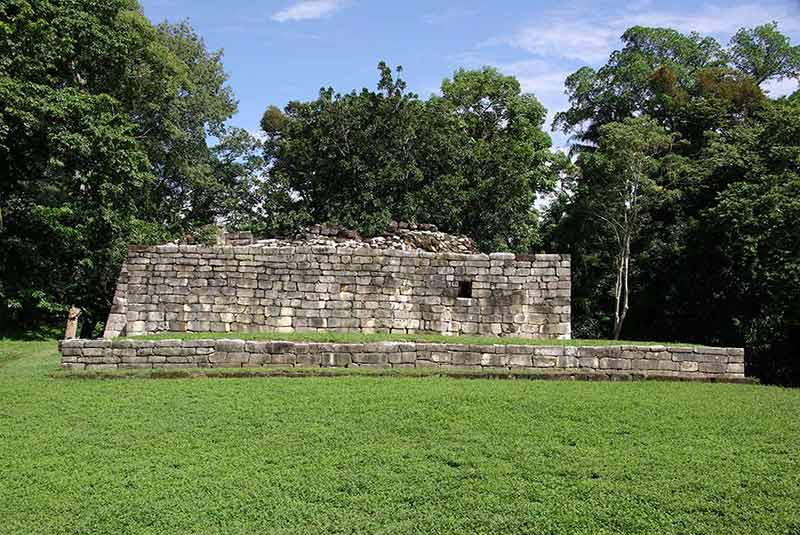
Quirigua is an important archaeological site from the ancient Mayans located in southeastern Guatemala, near the border with Honduras.
This site contains the Mayan empire’s largest and most well-preserved stone stelae.
The Mayans occupied this UNESCO World Heritage Site from around 400 B.C. until 1200 A.D.
Many structures and buildings have been excavated at Quirigua, including the Acropolis, which is the most prominent building.
Visitors to Quirigua can find giant monuments or stelae with discernible hieroglyphics prominently on display.
For more adventures in Mexico, read:
- 20 Things To Do In Tijuana
- 20 Things To Do In Merida
- 20 Things To Do In Ensenada
- 20 Tulum Day Trips
- Where To Stay In Tulum
- 20 Amazing Tulum Resorts
- 20 National Parks In Mexico
- 20 Day Trips From Mexico City
- 20 Day Trips From Cancun
- 20 Things To Do In Cancun With Kids
- 20 Things To Do In Mexico City At Night
- 20 Things To Do In La Paz
- 20 Things To Do In Monterrey Mexico
- 20 Things To Do In Acapulco
- 20 Things To Do In Chihuahua
- 20 Things To Do In Puerto Vallarta
- 20 Things To Do In Oaxaca
- 32 States In Mexico
- 20 Cities In Mexico
- 20 Islands In Mexico
- Where To Stay In Mexico City
- Everything You Need To Know About Lucha Libre (Mexican Wrestling)
- 15 Things Mexico Is Famous For
- 20 Overwater Bungalows and Beachfront Villas In Mexico
- 20 Famous Landmarks in Mexico
- 20 Best Beaches in Mexico
- 20 Ways To Spend Christmas in Mexico
- 10 Things To Do In Baja California
- The Wonder of Chichen Itza
- When Is The Best Time To Visit Mexico?
- A Guide To Las Grutas De Tolantongo
- A Guide To Valle De Bravo
- 20 Best Cenotes In Mexico
- 20 Interesting Mexican Traditions
- 20 Mayan Ruins In Mexico
- 20 Things To Do In Veracruz
- 25 Things To Do In Guadalajara
- 20 Mexican Cocktails and Drinks
- 20 Things To Do In Mazatlan
- 20 Things To Do In Cancun
- 20 Things To Do In Los Cabos
- 20 Things To Do In Nayarit
- 20 Things To Do In San Luis Potosi
- 20 Things To Do In Baja California Sur
- 20 Things To Do In Hidalgo
- 20 Things To Do In Guanajuato City
- 20 Things To Do In Zacatecas, Mexico
- 20 Things To Do In Huatalco, Mexico
- 20 Things To Do In Bacalar, Mexico
Plan Your Trip

Rent A Car – Find the best car rental rates at Discover Cars. They compare car hire companies to provide you with the best deal right now.

Find A Hotel – If you’re curious about this article and are looking for somewhere to stay, take a look at these amazing hotels.

